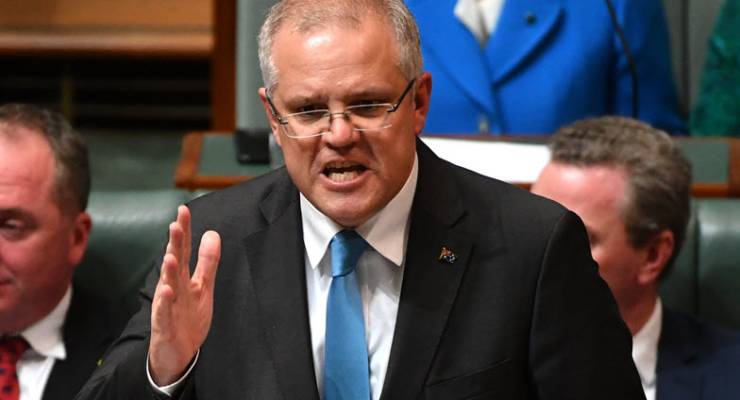
May is the month treasurers usually trumpet their triumphs and reveal their rosy vision of an imminent utopian future. This May, however, has been one Treasurer Scott Morrison might want to forget. It has been one of the weakest months for Australia’s economy since the Coalition came to office.
New “worst-ever” records were set for underemployment, total debt, the borrowing rate, wages and construction.
Gross and net debt deeper
The Office of Financial Management’s figures last Friday showed total gross debt at a record $495.7 billion. The Coalition has now added $225.8 billion in just three and a half years. That is much more than the $212.0 billion Labor added in its five years and nine months — during the global financial crisis.
Net debt, according to the Finance Department, was $317.4 billion at the end of April. That exceeds the $317.2 billion Morrison forecast in his December MYEFO for the full year to June.
Rate of debt increase
Gross borrowings in May were $7.55 billion, bringing the total new debt so far this financial year to $75.3 billion. That’s an extra $6.85 billion each month on average — the highest rate in Australia’s history.
That compares with the monthly rate of increase through Labor’s last 11 months of just $1.89 billion.
People unemployed
In April, 732,282 people were unemployed. This is the sixth consecutive month the total has been at or above 725,000. The last time that happened before the Coalition was elected in 2013 was back in 1997.
Full-time employment
Full-time jobs fell in April to 67.99% of all jobs, dropping below 68% for only the third time. All three were this financial year. January’s 67.73% was the lowest ever.
Hours worked per adult per month
This indicator — the best measure of real paid work — dropped in April to 83.80, the lowest since February 1994, before the Keating era structural reforms took effect.
The lowest this reached in the entire Howard period was 84.33 hours per adult per month. The Rudd/Gillard nadir was 85.71.
Jobless women
Women’s unemployment has been jammed at 6% for three months. It has been 5.7% or higher for 41 months. The last time that occurred was 1997 to 2000.
Underemployment
Workers who need to work more hours — in many cases desperately — breached one million in August 2014 after Joe Hockey’s first failed budget. It is now at a new record 1,114,558 workers. That’s up from 7.8% of the labour force when the Coalition took office to an all-time high 8.7%.
New house approvals
So far this year, January to April, approvals have numbered just 70,432. That is 13.5% below the same period last year and 13.7% below 2015. This is despite a housing shortage, plentiful cheap labour and record low interest rates.
Infrastructure
Total building and engineering construction for the March 2017 quarter, announced last week, showed yet another quarterly decline. That brings the number of declines to 12 out of the last 14 quarters — the worst result in Australia’s history.
March quarter activity was lower than for any quarter since March 2011, during the GFC. Yet labour and finance are cheap and new infrastructure urgently needed.
Wages
For the last two quarters, annual wages growth has been just 1.9%. This is the lowest since records have been kept, and below the 2.1% inflation rate.
Retail sales
As happens when wages are cut, retailers suffer first, then wholesalers, importers and others along the chain. Retail turnover for the 2017 first quarter was up just 2.64%, a real decline allowing for inflation and population. The only worst first quarter on record was 2.53% in 2010 at the depths of the global recession.
Interest rates at crisis low
At its May meeting, the Reserve Bank kept interest rates at 1.5%, the lowest in history, and well below the level Joe Hockey once asserted was evidence of a mismanaged economy.
Pointedly, bank governor Philip Lowe confirmed “a broad-based pick-up in the global economy since last year” and “forecasts for global growth have been revised up”.
Record profits but taxes dodged
Australia now enjoys robust annual growth, buoyant minerals exports, a booming farm sector and a near-record trade surplus. Companies are enjoying record revenues and profits in a sustained global upsurge.
So why are workers losing hours, pay and conditions? And why is there no money for infrastructure or to repay government debt?
The answer is in the monthly accounts under income tax revenue. This shows the government on track to collect company tax this financial year at its target of just $68,700 million. That is a fraction of the revenue which should be collected if companies were asked to pay their fair share.
In 2011-12, during the GFC, Wayne Swan collected $66,608. Way back in 2007-08, Peter Costello collected $61,700 million. If those collection rates applied today there would be abundant revenue. And much greater fairness.
Perhaps this also explains the bizarre absence in the mainstream media of accurate news about Australia’s appalling economic management. The corporations are cashing in while they can.
So maybe May was a good month for the treasurer, after all.








Crikey is committed to hosting lively discussions. Help us keep the conversation useful, interesting and welcoming. We aim to publish comments quickly in the interest of promoting robust conversation, but we’re a small team and we deploy filters to protect against legal risk. Occasionally your comment may be held up while we review, but we’re working as fast as we can to keep the conversation rolling.
The Crikey comment section is members-only content. Please subscribe to leave a comment.
The Crikey comment section is members-only content. Please login to leave a comment.